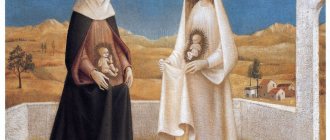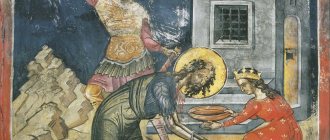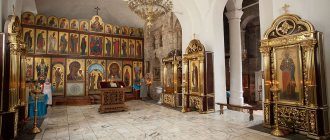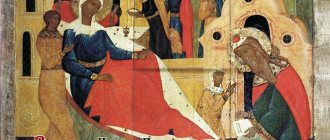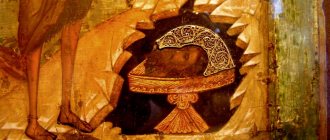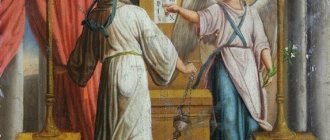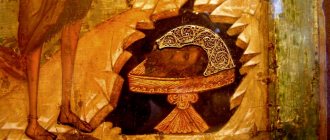We invite you to find out what holidays are celebrated on January 20, 2022 in Russia and around the world. These are World Cheese Lovers Day, International Penguin Awareness Day and Republic of Crimea Day in the Russian Federation. On this date, Orthodox Christians celebrate the Council of the Baptist and Baptist John. About what is special about the holiday, what you can and cannot do on January 20, what signs and traditions are followed on such a day, as well as who has a name day, read in the material of 24SMI.
Cathedral of John the Baptist. Holiday event
In the Orthodox Church, the custom has been established on the next day of the great feasts of the Lord and the Mother of God to honor the memory of those saints who served this sacred event in history. Thus, the day after Epiphany, the Church honors the holy prophet John the Baptist , who served the Baptism of Christ by laying his hand on the head of the Savior. The word “cathedral” means a meeting of people who give honor and praise to the holy prophet and Forerunner, John the Baptist of the Lord. John the Baptist is a great prophet who completes the history of the Old Testament Church and opens the era of the New Testament. “We celebrate the Council of the Honest Forerunner above tradition, as I served the mystery of divine baptism” (Great Menaion of Chetia, collected by All-Russian Metropolitan Macarius). The Holy Prophet John testified to the coming to earth of the Only Begotten Son of God, who took on human flesh. John the Baptist was honored to baptize Him in the waters of the Jordan and testified to the mysterious Appearance of the Most Holy Trinity on the day of the Baptism of the Savior.
Library of the Russian Faith Cathedral of St. John the Baptist. Great Menaion of Cheti →
Read online in original
Witness to a miracle
Later, having reached his thirtieth birthday, the saint began to walk around different cities and outskirts of the country of Jordan and preach. He called on the people to think about their sinful lives, repent and be baptized. By his personal example, he taught people to live righteously and piously. John the Baptist's goal was to call people to the true faith.
Saint John is called both the Forerunner and the Baptist. This is due to the fact that it was he who marked the recognition of Jesus Christ as the Son of God by seeing a miracle - the descent of the Holy Spirit on him as a dove, accompanied by the voice of the Almighty from the open heavens. This event took place during the Baptism of the Messiah.
Cathedral of John the Baptist. history of the holiday
John the Baptist was born into the family of the priest Zechariah and the righteous Elizabeth . Zechariah and Elizabeth, having lived to old age, had no children. But the Lord heard their prayers, and Archangel Gabriel announced the birth of his son to the priest Zechariah while he was in the temple. When King Herod, having learned from the Magi about the birth of Jesus Christ, ordered to kill all the babies in Bethlehem, the mother of John the Baptist, Elizabeth, managed to leave with her son into the desert. His father, Zechariah, served in the Temple of Jerusalem these days. When they came to him with a demand to hand over his son, the priest replied: “I now serve the Lord God of Israel, but where my son is now, I don’t know.” Angry soldiers killed him right near the altar. Nothing is known about the childhood and youth of John the Baptist. John grew up in the wild and ethereal desert, preparing himself for prophetic service through strict fasting, contemplation of God and prayer. At the age of about 30, John went out preaching to the banks of the Jordan River, thereby preparing the people to accept the Savior of the world. Many, imbued with the words of the great preacher, were baptized in the waters of the Jordan. The Lord Jesus Christ himself came to the Jordan to receive baptism from John.
Baptism of the Lord, icon, 16th century
After the Baptism of the Savior, John continued his preaching, calling people to repentance, denouncing sins and vices. John the Baptist ended his earthly life as a martyr. He denounced King Herod Antipas (20 BC - after 39 AD) for leaving his lawful wife and cohabiting with Herodias, the wife of his brother Philip. John was captured and imprisoned. During the celebration of his birthday, Herod held a feast, to which many nobles, a thousand chiefs and elders were invited. Salome, the daughter of Herodias, appeared at the feast, who pleased the king with her dancing, and he ordered her to ask him for everything she wanted. She consulted with her mother, who, having decided to take revenge on John for his accusations, told her daughter to ask Herod for the head of John the Baptist. Herod was saddened; he feared the wrath of God for the murder of the Prophet, whom he himself had previously obeyed; he also feared the people who loved the holy Forerunner. However, because of the guests and the lawless oath, he sent a soldier to prison to cut off the head of John the Baptist and give it to Salome. The God-fearing and pious Joanna, the wife of Herod’s steward, Khuza, secretly took the holy head of John the Baptist and buried it in an earthen vessel on the Mount of Olives. That same night, the disciples of the Forerunner took the holy body and buried it in Sebastia, where the murder was committed. When rumors reached the royal palace about the preaching of Jesus Christ and the miracles He performed, Herod and his wife Herodias went to check whether the head of John the Baptist was in place. Not finding her, they began to think that Jesus Christ is the resurrected John the Baptist, as evidenced by the Gospel (Matthew 14:2; Luke 9:9-7). The relics of John the Baptist (except for the head and right hand) were burned along with the Sebastian Temple by order of Emperor Julian the Apostate in 362.
Signs for the Council of the Baptist and Baptist John
- A clear and sunny day means a hot and dry summer.
- Cloudy weather and snowfall mean a rich harvest.
- Fog in the morning - we were expecting a good grain harvest.
- A lot of bright stars in the sky means frost. There are few or no stars in the sky - warming.
- The wind blows from the south - leading to frequent thunderstorms in summer.
- Blizzard on January 20 - the same weather is expected for Maslenitsa.
- The echo is heard far away - it means it will soon get colder.
- Birds sing loudly in the morning - the thaw. Birds do not fly away from houses - due to cold weather.
- Meeting a goose or swan on the street will make your cherished wish come true.
Troparion and Kontakion for the Feast of the Cathedral of John the Baptist
Troparion, p®techi, voice, v7.
Remembrance of the righteous with 8 praises, you are satisfied with the testimony of more than anything else, kwi1l bo sz є3si2 truly the most honest prophet, ћko and 3 in 8 bhstrinakh krti1ti spod0bilsz є3si2 preached. at the same time, having truly suffered. He preached the gospel of the world, and of the world that gives us great mercy.
Code, voice, *7. self-voice.=
Pl0tskagw thi2 will come, with0 fear of return. The prophetic ministry is completed by the awe of the Holy Spirit. ѓgGlstіi chi1ni divlskhusz, zrsshe tz in the waters of flesh kRschaema. and3 all2 that exist in this enlightenment, praising tS ћvlshagosz, and3 enlightenment of everything.
Martyrdom
John the Baptist was beheaded by the ruler Herod Antipas at the request of Queen Herodias and her daughter Salome. He suffered for exposing their sins and vices. Already dead, the righteous man publicly denounced the king’s adultery. Then Herodias, having pricked her tongue with a needle, buried her head in an unclean place. Subsequently, pious people reburied the shrine on the Mount of Olives in a clay vessel. The body was buried in Sebastia.
One of the strongest in the Orthodox religion is the prayer to John the Baptist. The Christian faith calls to honor the memory of the holy prophet not only on church holidays associated with him, but also not to forget to turn on other days for help or with gratitude. The Cathedral of John the Baptist is a large and significant religious holiday for all believers.
Temples and icons in honor of the Cathedral of John the Baptist in Rus'
There is no information about churches in honor of the Council of John the Baptist, built before the schism of the Russian Orthodox Church, as well as about Old Believers.
Iconographic images of the Cathedral of the Holy Glorious Prophet and the Forerunner of the Baptist John are rare. There is a well-known icon of the Cathedral of John the Baptist from the 19th century (wood, gesso, tempera, gilding, size 36 × 31.5 cm). Saint John the Baptist is depicted surrounded by saints. Above the prophet John himself is depicted the Savior (Image Not Made by Hands) and the Mother of God.
Icon of the Cathedral of St. John the Baptist. Russia, XIX century
Icon of the Cathedral of St. John the Baptist
What you can and cannot do on January 20
While visiting the temple, they asked for the salvation of the soul and prayed for good health, paying tribute to the memory of John the Baptist.
The consumption of alcoholic beverages on this day should be extremely moderate. Exceeding the measure can bring misfortune and poverty into the house.
The feast did not start with first courses due to the risk of not achieving the goals until the end of the year.
Throughout the day it was impossible to be lazy and suffer from idleness. Cleaning, cooking, handicrafts, and even the hardest work were encouraged.
We abstained from water procedures. There was a belief that along with the dirt on January 20, you could wash away your health and good luck.
Hunting and fishing were prohibited. It was impossible to offend any living creatures on such a day.
They didn’t take anything into their own hands from strangers, afraid to take on other people’s troubles and illnesses along with their things.
Taking into account the fact that the second day of Epiphany was celebrated on January 20, there had to be Epiphany water on the table, which was consumed first on an empty stomach.
The day was perfect for the baptism of children. They believed that in this case they would gain good health and happiness for the rest of their lives.
It was impossible to refuse help to anyone, especially family and friends. Any manifestations of stinginess and greed, as expected, were then severely punished.
All day it was necessary to wear only light and clean clothes. Thoughts also had to be bright.
It was forbidden to count change, so as not to become a petty person and not attract financial problems into your life.
They tried to remember their dreams at the Council of John the Baptist. It was believed that they could come true in the next week.
Tombs of the Pskov princesses
- The Pskov princesses are buried here!
— Since the 13th century, the temple served as a tomb for the Pskov princesses. We know that more than ten princesses are buried here, among them the famous princess, granddaughter of the Holy Blessed Prince Alexander Nevsky - Maria Dmitrievna, wife of the Blessed Prince Dovmont-Timothy, Martha in the monasticism. Many famous townspeople are also buried here.
- And there was a cemetery here?
— The monastery operated before the revolution. In 1923 it was closed. The nuns were expelled from the monastery and they were forced to go into the world, to save themselves among the worldly population. In the summer of 1925, city authorities decided to destroy the monastery cemetery. Pskov residents were asked to rebury their relatives in other cemeteries in the city. That’s why we no longer see burials here; they were completely destroyed during the 20th century. Although some slabs come to the surface.
— Was the cathedral damaged much during the war?
- Yes! The roof of the cathedral was damaged, the 18th-century Church of St. Andrew the First-Called with the chapel of St. Seraphim of Sarov was practically destroyed. Only the ancient cathedral remains. Thanks to the efforts of restorers such as Pyotr Maksimov, Boris Skobeltsyn and Sergei Mikhailov, the cathedral was not only revived, but also given its ancient forms. That is, the roof covering and the fact that we see the ancient helmet-shaped heads of the domes are all due to the fact that great research work was carried out here, and the cathedral acquired an ancient, original appearance.
Prince the Builder
“The Cathedral of the Nativity of John the Baptist in the city of Pskov is the oldest functioning church in our city,” says Father Mardari, treasurer of the Krypetsky monastery. – According to legend, it was founded by the blessed princess, the Venerable Euphrosyne Rogvolodovna, in monasticism – Eupraxia. The Pskov Chronicle mentions that she was buried in the Church of John the Baptist in 1243. And for some time this date was considered the time of the founding of the temple.
- But there are more recent studies...
— Indeed, the latest research of the 20th century, including our Pskov architect Sergiy Mikhailov, suggests that the dating may be pushed back 100 years earlier. This conclusion can be drawn from the plinth used there, which is not typical for Pskov. And the features of Novgorod architecture give reason to believe that the temple dates back to the 1120-1130s of the 12th century. So it can be argued that the history of the temple begins precisely from that time. Perhaps the founder and builder of the temple was the noble prince Vsevolod-Gabriel. Although he reigned in Pskov for only a year, he left the memory of St. John the Baptist with the construction of this temple.
